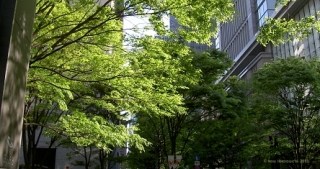
Hagiwara Sakutaro (1886 – 1942 JPN, poet)
萩原 朔太郎 (詩人)
—————————————————-
Kikyou [ 帰 郷 ― Return Home ]
—————————————————-
In the 4 year of the Showa era,
in winter (1929),
I got a divorce from my wife
and returned home
with my two daughters.
—————————————————-
The day I return home
the owl train
that heads for Jyoshu
with us on board
bursts through
the dry blast into the cold air
I awake from my catnap
by the wheel window
then the steamer barks frantically
the light emanated
from the fire in the boiler
lights up the dark wilderness
the range of mountains in Jyoshu
does not come into my sight
through the window yet
my daughters
who are saddened
at the loss of their mother
have sobbed themselves to sleep
under the dim lamp
in the passenger owl train
passengers give us
quizzical glances wonderingly
Alak, I run away
and escape from Tokyo again
Alak, Where am I bound for ?
My past continues
into the desolate valley
of my native country
My future heads
for the complete folorn strand
of my homeland
It’s a shame
As if my life is made from
all sand and gravel materials of my natal place !
I have already took the nosedive
I feel bored to keep alive under
such hopeless circumstances gloomily
Suffering poor cat !
I return home alone
and I would stand by Tonegawa river
be it bad again
The night train run down
through the vast wilderness
Does the relentless will of Nature
drive me to the depth of despair ?
Is it out to ruin me ?
I arch my back against her will
and her lack of clemency
Hagiwara Sakutaro
from “HyouTou (Ice Isle)” (1934)
(translating by Takashi Ikenouchi)
—————————————————-
帰 郷
—————————————————-
昭和四年の冬、妻と離別し二児を抱へて故郷に帰る
わが故郷に帰れる日
汽車は烈風の中を突き行けり。
ひとり車窓に目醒むれば
汽笛は闇に吠え叫び
火焔(ほのほ)は平野を明るくせり。
まだ上州の山は見えずや。
夜汽車の仄暗き車燈の影に
母なき子供等は眠り泣き
ひそかに皆わが憂愁を探(さぐ)れるなり。
鳴呼また都を逃れ来て
何所(いづこ)の家郷に行かむとするぞ。
過去は寂寥の谷に連なり
未来は絶望の岸に向へり。
砂礫(されき)のごとき人生かな!
われ既に勇気おとろへ
暗憺として長(とこし)なへに生きるに倦みたり。
いかんぞ故郷に独り帰り
さびしくまた利根川の岸に立たんや。
汽車は曠野を走り行き
自然の荒寥たる意志の彼岸に
人の憤怒(いきどほり)を烈しくせり。
萩原朔太郎「氷島」(1934年刊)より
(群馬県前橋市の敷島公園にこの詩碑がある)
萩原朔太郎【はぎわら さくたらう】
明治19年~昭和17年 (1886-1942) 詩人。父密蔵は前橋の開業医。前橋中学校卒業
後、熊本の第五、岡山の第六高等学校に学んだが中退。1917年詩集『月に吠える』に
よって、日本近代詩に不滅の金字塔をうちたてた。朔太郎の詩業は、近代的思想を感
覚的にうたいあげ、我が国における口語自由詩を確立した。『青猫』『氷島』などの
詩集のほか、多くの評論集がある。墓所は市内田口町政淳寺にある。
詩篇小解「帰郷」
昭和四年。妻は二児を残して家を去り、杳(よう)として行方を知らず。我れ独り後
に残り、蹌跟(そうろう)として父の居る上州の故郷に帰る。上野発七時十分、小山
行高崎廻り。夜汽車の暗爾(あんじ)たる車燈の影に、長女は疲れて眠り、次女は醒
めて夢に歔欷(きよき)す。声最も悲しく、わが心すべて断腸せり。既にして家に帰
れば、父の病とみに重く、万景悉く蕭条たり。
びあんき金井 (aaabianchi)-san のHPより











![Takashi Ikenouchi [Shūson] / 池ノ内 孝 [秋村]](https://kouikenouchi.wordpress.com/wp-content/uploads/2017/03/2017600317wb01a.jpg?w=312)


